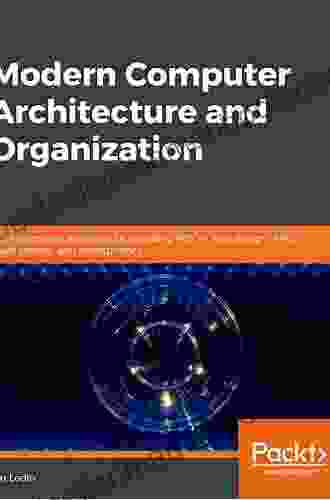Delving into the Labyrinth of Modern Computer Architecture and Organization: A Comprehensive Exploration

In the realm of computing, the architecture and organization of computers serve as the fundamental blueprints that govern the intricate interplay of hardware and software components. These elements play a pivotal role in determining the capabilities, performance, and efficiency of modern computing systems. This article embarks on a journey into the fascinating world of computer architecture and organization, delving into the complexities that underpin the operation of today's digital marvels.
The Essence of Computer Architecture
Computer architecture encompasses the fundamental design principles and concepts that define the structure and behavior of a computer system. It involves the organization of hardware components, the instruction set architecture (ISA),and the interconnections between various subsystems. The ISA, in particular, acts as the interface between the hardware and software, specifying the instructions that the processor executes and the data formats it handles.
4.7 out of 5
| Language | : | English |
| File size | : | 13160 KB |
| Text-to-Speech | : | Enabled |
| Screen Reader | : | Supported |
| Enhanced typesetting | : | Enabled |
| Print length | : | 562 pages |
Modern computer architecture has evolved significantly over the decades, driven by advancements in semiconductor technology and the ever-growing demands of computing applications. Today's architectures are characterized by:
- Multi-core processors: Multiple processing cores integrated into a single chip, enabling parallel execution and increased performance.
- Superscalar architecture: Processors that can execute multiple instructions simultaneously, exploiting instruction-level parallelism.
- Out-of-order execution: Processors that reorder instructions for optimal execution, maximizing efficiency.
- Cache memory: High-speed memory caches that store frequently accessed data and instructions, reducing memory access latency.
Computer Organization: The Practical Implementation
Computer organization refers to the physical realization of the computer architecture. It involves the interconnection of hardware components, the design of memory hierarchies, and the implementation of input/output (I/O) systems. The primary components of a computer organization include:
- Processor: The central processing unit (CPU) that executes instructions and performs calculations.
- Memory: The storage medium that holds programs and data during execution.
- Input/output devices: Devices that allow the computer to communicate with the external world, such as keyboards, mice, and monitors.
Computer organization plays a crucial role in optimizing system performance by minimizing bottlenecks and ensuring efficient data flow between components. It also involves addressing issues such as memory management, address translation, and interrupt handling.
Types of Computer Architectures
There exists a wide array of computer architectures, each tailored to specific applications and performance requirements. Some notable types include:
- Von Neumann architecture: The traditional architecture where the same memory is used for both instructions and data.
- Harvard architecture: A modified Von Neumann architecture that separates instruction and data memory, improving performance for certain applications.
- RISC (Reduced Instruction Set Computing): Architectures with a simplified instruction set, optimizing for faster execution.
- CISC (Complex Instruction Set Computing): Architectures with a more comprehensive instruction set, offering greater functionality but potentially slower performance.
- SIMD (Single Instruction Multiple Data): Architectures designed for parallel processing of large data sets, commonly used in graphics and multimedia applications.
Instruction Set Architecture: The CPU's Language
The instruction set architecture (ISA) is a critical aspect of computer architecture that defines the interface between the software and hardware. It encompasses:
- Instruction set: The collection of instructions that the processor can execute.
- Data types: The different types of data that the processor can manipulate.
- Addressing modes: The mechanisms used to access memory and data.
The ISA plays a significant role in determining the performance, compatibility, and ease of programming for a given architecture.
Memory Hierarchies: Optimizing Data Access
Modern computer systems employ memory hierarchies to optimize data access. These hierarchies consist of different levels of memory with varying speeds and capacities:
- Registers: High-speed memory within the processor, providing the fastest access but limited capacity.
- Cache memory: Smaller, faster memory located between the processor and main memory, storing frequently accessed data and instructions.
- Main memory (RAM): The primary memory that stores programs and data during execution, offering larger capacity but slower access than cache memory.
- Secondary storage (HDD, SSD): Non-volatile storage devices that hold large amounts of data, such as operating systems and user files.
By organizing memory in this hierarchical manner, systems can achieve both high performance and cost-effectiveness.
Input/Output Systems: Connecting to the World
Input/output (I/O) systems provide the means for computers to interact with the external world. These systems consist of:
- I/O devices: Devices such as keyboards, mice, and monitors that allow users to interact with the computer.
- I/O controllers: Hardware components that manage communication between I/O devices and the processor.
- I/O buses: Pathways that connect I/O devices and controllers to the processor.
Efficient I/O systems are crucial for ensuring responsive performance and seamless user interaction.
Multiprocessor and Distributed Systems
In response to the ever-growing demand for computing power, multiprocessor and distributed systems have emerged. These systems employ multiple processors to achieve higher performance:
- Multiprocessor systems: Multiple processors share the same memory and I/O resources, operating in a tightly coupled environment.
- Distributed systems: Multiple computers interconnected over a network, sharing resources and communicating via message passing.
Multiprocessor and distributed systems offer increased scalability, fault tolerance, and overall performance for demanding applications.
Virtualization: Abstraction and Consolidation
Virtualization is a technology that abstracts the physical hardware resources of a computer system, allowing multiple virtual machines to run on a single physical machine. This technique offers numerous benefits:
- Resource consolidation: Multiple virtual machines can share the same hardware, maximizing utilization and reducing costs.
- Application isolation: Virtual machines provide isolated environments for applications, improving security and stability.
- Portability: Virtual machines can be easily moved between different physical servers without affecting their operation.
Virtualization plays a vital role in modern cloud computing and data center environments.
The intricate tapestry of modern computer architecture and organization underpins the remarkable capabilities of today's computing systems. Understanding these concepts empowers us to appreciate the complexities involved in designing, implementing, and optimizing these digital marvels. As technology continues to evolve, the frontiers of computer architecture and organization will undoubtedly continue to expand, propelling us into an even more connected and computationally empowered future.
4.7 out of 5
| Language | : | English |
| File size | : | 13160 KB |
| Text-to-Speech | : | Enabled |
| Screen Reader | : | Supported |
| Enhanced typesetting | : | Enabled |
| Print length | : | 562 pages |
Do you want to contribute by writing guest posts on this blog?
Please contact us and send us a resume of previous articles that you have written.
 Top Book
Top Book Novel
Novel Fiction
Fiction Nonfiction
Nonfiction Literature
Literature Paperback
Paperback Hardcover
Hardcover E-book
E-book Audiobook
Audiobook Bestseller
Bestseller Classic
Classic Mystery
Mystery Thriller
Thriller Romance
Romance Fantasy
Fantasy Science Fiction
Science Fiction Biography
Biography Memoir
Memoir Autobiography
Autobiography Poetry
Poetry Drama
Drama Historical Fiction
Historical Fiction Self-help
Self-help Young Adult
Young Adult Childrens Books
Childrens Books Graphic Novel
Graphic Novel Anthology
Anthology Series
Series Encyclopedia
Encyclopedia Reference
Reference Guidebook
Guidebook Textbook
Textbook Workbook
Workbook Journal
Journal Diary
Diary Manuscript
Manuscript Folio
Folio Pulp Fiction
Pulp Fiction Short Stories
Short Stories Fairy Tales
Fairy Tales Fables
Fables Mythology
Mythology Philosophy
Philosophy Religion
Religion Spirituality
Spirituality Essays
Essays Critique
Critique Commentary
Commentary Glossary
Glossary Bibliography
Bibliography Index
Index Table of Contents
Table of Contents Preface
Preface Introduction
Introduction Foreword
Foreword Afterword
Afterword Appendices
Appendices Annotations
Annotations Footnotes
Footnotes Epilogue
Epilogue Prologue
Prologue Paul Mason
Paul Mason Catherine Jones Payne
Catherine Jones Payne Boris Kachka
Boris Kachka Lindsay Swearingen
Lindsay Swearingen Roger Moorhouse
Roger Moorhouse Brad Benefield
Brad Benefield Tim Dorsey
Tim Dorsey Bonnar Spring
Bonnar Spring Dheeraj Mishra
Dheeraj Mishra Nicole M Avena Ph D
Nicole M Avena Ph D Arx Reads
Arx Reads Elin Hilderbrand
Elin Hilderbrand Genevieve Graham
Genevieve Graham Wayne Au
Wayne Au William Kent Krueger
William Kent Krueger Marifran Korb
Marifran Korb Ruth Downie
Ruth Downie Ashley Foster
Ashley Foster Ben Robson
Ben Robson J R Ward
J R Ward
Light bulbAdvertise smarter! Our strategic ad space ensures maximum exposure. Reserve your spot today!
 Edgar HayesFollow ·2.2k
Edgar HayesFollow ·2.2k Nikolai GogolFollow ·9.8k
Nikolai GogolFollow ·9.8k Simon MitchellFollow ·5.4k
Simon MitchellFollow ·5.4k Harold PowellFollow ·12.7k
Harold PowellFollow ·12.7k Ruben CoxFollow ·8.5k
Ruben CoxFollow ·8.5k Caleb LongFollow ·3.5k
Caleb LongFollow ·3.5k Ivan CoxFollow ·10.8k
Ivan CoxFollow ·10.8k Aldous HuxleyFollow ·17.1k
Aldous HuxleyFollow ·17.1k

 David Foster Wallace
David Foster WallaceA Comprehensive Journey Through Economic Thought: A Brief...
Economics, the study of...

 Phil Foster
Phil FosterRecipes for Two: Nourish Your Body, Nourish Your...
Cooking and sharing meals together is one of...

 Alexandre Dumas
Alexandre DumasThe Ultimate Monkey Hat: Emery Leeann
If you're an animal lover,...

 Chadwick Powell
Chadwick PowellThe Breakbeat Poets Vol. 4: Black Girl Magic - Unveiling...
In the realm of...

 Dan Brown
Dan BrownAn Emotional and Touching Love Story: A Journey of Love,...
This is a love story that will stay with you...
4.7 out of 5
| Language | : | English |
| File size | : | 13160 KB |
| Text-to-Speech | : | Enabled |
| Screen Reader | : | Supported |
| Enhanced typesetting | : | Enabled |
| Print length | : | 562 pages |














